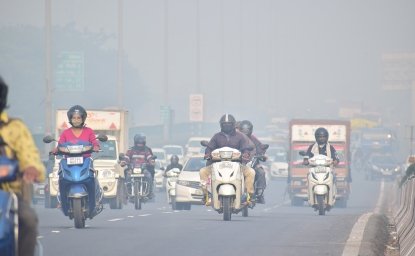
A blog of the Wilson Center

In 2023, for the first time ever, a majority of the “irregular migrant encounters” at the US-Mexico border originated from beyond Mexico and the Northern Triangle.
When it comes to coverage of migration—especially migration at our southern border—US media tends to focus solely on the overall numbers. It’s easy to see why: in Fiscal Year 2023, there were nearly 2.5 million “irregular encounters” at the US-Mexico border—that’s US Customs and Border Protection (CBP) terminology for expulsions and apprehensions of migrants. This broke FY2022’s record of 2.2 million which, in turn, broke the previous year’s record of 1.6 million. But the more interesting story is where those migrants are coming from—and how quickly it is shifting.
In 2023, for the first time ever, more than half of those reaching the US-Mexico border originated beyond Mexico and the Northern Triangle countries of Honduras, Guatemala, and El Salvador. In 2020, according to the Migration Policy Institute’s analysis of CBP data, only 12% involved migrants from beyond those four countries.
Many Americans have long assumed that nearly all undocumented migrants reaching the US were Mexican. In fairness, it was and is true that Mexico is the single-largest origin country for such migrants. But in FY2023, Mexican citizens made up only 23% of irregular migrant encounters nationwide. Taken together, the Northern Triangle countries accounted for 500,723 encounters in FY2023. That’s a 36% drop from FY2021 to roughly 16% of all encounters.
So where are irregular migrants coming from? The numbers vary by year and depend on external factors like conflict, natural disasters, economic downturns, crime, and political repression. There have been waves of desperate Cubans fleeing government crackdowns by Castro and his successors. Between 2022 and 2023, nearly 500,000 Cubans submitted asylum applications to the US and Mexico—over 4% of the island’s population. There have been waves of Haitians trying to escape violence and economic chaos sowed by political instability and the rise of gangs. And there have been waves of migrants heading to the US-Mexico border from the Northern Triangle driven in large part by economic crises and natural disasters, from ruinous coffee rusts to more powerful hurricanes and floods to crime and insecurity.
But in recent years, migrants are increasingly coming from much further afield. By 2023, Venezuelans fleeing the corruption and mismanagement of the Maduro regime was the second-largest nationality of migrant encounters at the US-Mexico border. The numbers of Peruvians, Colombians, Cubans, and Ecuadorians have also risen as more individuals make the dangerous trek through the Darién Gap—the slim stretch of wild jungle between Colombia and Panama. Even more striking is that countries thousands of miles from the border are beginning to contribute material numbers of migrants. In the recent 7,000-person-plus migrant caravan making its way across Mexico, individuals claimed to hail from 24 different countries, including Iran, Turkey, Syria, and Cameroon.
The number of asylum seekers from China has also been trending upward since February 2023, with more than 52,000 recorded encounters in FY2023, and an additional 14,000 since the start of the new fiscal year. The US is by far the largest destination for hopeful Chinese asylees, driven by a desire to escape Xi Jinping’s crackdown on civil society and individual freedoms ranging from expression to religion. We’ve seen a similar uptick in migrants from India following diminishing protections for Christians, Muslims, and Sikhs under Prime Minister Narendra Modi—in FY2023, nearly 42,000 encounters along the US southern border were Indian nationals, an increase of 128% from FY2022.
And while encounters from citizens of countries across Africa remain categorized as “other” by the CBP, data analyzed by the New York Times found approximately 52,000 individuals from the continent were apprehended at the US-Mexico border in FY2023. With Europe tamping down on irregular migration, including through the recent passage of the EU’s Pact on Migration and Asylum, more refugees and migrants across the African continent are fleeing to Nicaragua then trekking to our border on foot.
Why does this shift matter? Some of the policy tools we’ve been using in an attempt to control migration are likely to prove inadequate—such as the Partnership for Prosperity/Remain in Mexico policy, where we have repatriation agreements with Mexico and Central American countries.
I once heard a political leader say that too often we launch fact finding initiatives when we really need fact facing ones. The US and Mexico are grappling with migration and displacement challenges that are, to paraphrase an old automobile ad campaign, “not your father’s” challenges. Not in terms of numbers or countries of origin or root causes. In other words, it’s time to face the facts, and get to work addressing them.
Author

Explore More in Stubborn Things
Browse Stubborn Things
Spying on Poachers

China and the Chocolate Factory

India: Economic Growth, Environmental Realities
